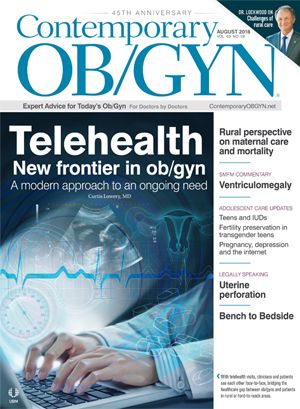The neglected challenge: Saving America’s rural ob care
More than half of rural counties in the United States have no hospital obstetrical services, many remaining services are closing at a frightening pace, and maternal and perinatal mortality and/or morbidity are rising as a consequence.
Charles J. Lockwood, MD, MHCM

" target="_blank">
Often overlooked in the debate over health care reform are the growing disparities in health outcomes among America’s rural population. Overall mortality and age-adjusted annual death rates from heart disease, cancer, unintentional injury, chronic lower respiratory disease and stroke are all higher in rural compared with urban settings.1 Americans who live in rural counties are more likely to be obese, older, poorer, and addicted to opioids than their urban counterparts. However, reduced access to high-quality medical care is also a major contributor to adverse health outcomes in rural populations. At the heart of reduced rural access is a shortage in providers and hospitals. Rising health care fixed costs and declining reimbursement are exacerbating the problem. Indeed, it has been estimated that 673 of 2,161 rural hospitals (31.1%) may close over the next 5 years.2
Childbirth is the most common reason for hospitalization in the United States and 28 million women of reproductive age live in rural counties giving birth to 500,000 infants each year.3Rural hospital obstetrical services are especially vulnerable financially due to their very high fixed costs, low patient volumes, and heavy dependence on often-meager Medicaid-based reimbursements. Thus, it shouldn’t come as a surprise that more than half of rural counties in the United States have no hospital obstetrical services, many remaining services are closing at a frightening pace, and maternal and perinatal mortality and/or morbidity are rising as a consequence.
Rural access to obstetrical services is declining
Hung and associates analyzed the availability of inpatient obstetrical services in rural US hospitals between 2004 and 2014 using multiple data sources including the Centers for Medicare and Medicaid Services (CMS), the American Hospital Association and the Census Bureau.3 They defined rural counties as micropolitan, if they had an urban core of 10,000 to 50,000 residents, and non-core, if no such “urban” core was present. The authors further analyzed their data based on whether the rural county was adjacent to an urban area or not. They found that in 2004, 45% (898) of rural counties had no hospital-based obstetrical service. These counties had significantly fewer family physicians per capita, a higher percentage of African-American women of reproductive age, lower median household incomes, a higher percentage of residents in poverty and their states had more stringent household income thresholds for pregnant women to be eligible for Medicaid – all risk factors for adverse pregnancy outcomes.
By 2014, a further 9% (179) of rural counties had lost their hospital-based obstetrical services. When compared with micropolitan counties, non-urban core counties were more likely not to have hospital-based obstetrical services (17.6% vs. 58.6%) and were more likely to have lost their inpatient obstetrical service (4.5% vs. 11.2%). Worst yet, 59% of noncore rural US counties not adjacent to an urban area, the most isolated of our population, had no hospital-based obstetrical services in 2004 and by 2014 that share had increased to 69%.
In contrast, rural counties with obstetrical services in 2004 who maintained them over the next decade had significantly more births, more obstetricians and certified nurse midwives per capita, higher median incomes and less stringent income-eligibility thresholds for pregnant women to obtain Medicaid. In 2018, such thresholds varied from an appalling 138% of the federal poverty line in Idaho and South Dakota to a generous 380% in Iowa.4
Next: Loss of hospital-based OB services adversely impact outcomes
Loss of hospital-based OB services adversely impact outcomes
Delivery in rural hospitals is associated with higher rates of postpartum hemorrhage.5Moreover, infant mortality rates are 6% higher in rural compared with large urban counties.6Among non-Hispanic black women, this geographic difference in infant mortality reaches 16%. However, loss of inpatient obstetrical services adds an additional pregnancy-related health threat. Kozhimannil and associates examined the impact of loss of hospital-based obstetrical services on birth outcomes between 2004 and 2014.7For rural, non-urban adjacent and urban-adjacent counties, the out-of-hospital birth rates were 1.2% and 1.3%, respectively, the year before they lost their hospital-based obstetrical services. For non-urban and urban-adjacent areas, the rate of such deliveries increased 1.6% and 1.5%, respectively, the year following loss of services. Similarly, rates of delivery at hospitals without obstetrical services increased in rural, non-urban adjacent counties from 0.37% to 2.47% the year after service loss. In rural, urban-adjacent counties, loss of services increased deliveries at hospitals without obstetrical services from 0.01% to 1.88%.
Multivariate analysis suggested that even after controlling for potential confounders, rates of preterm birth increased in rural, non-urban adjacent areas by 0.67% (95%CI: 0.02-1.33) and patients receiving ≤ 10 prenatal care visits increased in such counties by 4.37% (95%CI: 2.33-6.41). Lesser and more transient effects were seen in rural, urban-adjacent counties that lost their inpatient obstetrical services.
Potential solutions
The solution to this rural obstetrical access problem is not straightforward. Even if state or federal government subsidies were provided to keep units open, it is not entirely clear there would be sufficient numbers of providers to staff them. More importantly, even if adequately staffed, facilities with very low volumes would likely be at risk for reduced quality since volume is an important determinant in maintaining quality outcomes. The current impasse in Washington over revising the Affordable Care Act and the failure of 27 states to undertake Medicaid expansion adds additional challenges, particularly as the latter states often have the most counties without obstetrical services.
There are, however, some pragmatic approaches that could be taken. The first is to set a national policy to ensure that all pregnant women whose household incomes are within 300% of the federal poverty line are eligible for Medicaid. Second, peg a given area’s aggregate rural hospital and provider reimbursements to a figure that covers their provider’s high fixed costs. One such approach is to substitute a global budget payment based on historic revenue for traditional fee-for-service payments in rural hospitals – such an experiment is currently being undertaken by CMS in Pennsylvania.8 This approach could easily be employed just for obstetrical services with the budget set to cover fixed and variable provider costs. These first two solutions would address the financial sustainability of rural inpatient obstetrical services.
To address the issue of maintaining quality in low-volume settings, each state should have in place a robust regional maternal/perinatal care program designed to minimize both perinatal and maternal mortality.
Such a program should include increased use of:
- telemedicine, which has been used successfully to enhance outcomes in rural intensive care units;
- safety drills and simulation;
- maternal air transport;
- induction of labor at 39 weeks.
The latter is associated with reduced perinatal morbidity and mortality, maternal morbidity, and cesarean delivery rates and helps mitigate the logistical issues imposed by geographic distance from providers
References:
- Garcia MC, Faul M, Massetti G, et al. Reducing potentially excess deaths from the five leading causes of death in the rural United States. MMWR Surveill Summ. 2017 Jan 13;66(2):1-7.
- Morse S. More than 200 rural hospitals are close to closure, iVantage study claims. http://www.healthcarefinancenews.com/news/more-200-rural-hospitals-are-close-closure-ivantage-study-claims Accessed 5/27/2018.
- Hung P, Henning-Smith CE, Casey MM, Kozhimannil KB. Access to obstetric services in rural counties still declining, with 9 percent losing services, 2004-14. Health Aff (Millwood). 2017 Sep 1;36(9):1663-1671.
- Brooks T, Wagnerman K, Artiga S, Cornachione E. Medicaid and CHIP eligibility, enrollment, renewal, and cost sharing policies as of January 2018: findings from a 50-state survey. https://www.kff.org/report-section/medicaid-and-chip-eligibility-enrollment-renewal-and-cost-sharing-policies-as-of-january-2018-findings-from-a-50-state-survey-medicaid-and-chip-eligibility/ Accessed 5/27/2018.
- Kozhimannil KB, Thao V, Hung P, Tilden E, Caughey AB, Snowden JM. Association between hospital birth volume and maternal morbidity among low-risk pregnancies in rural, urban, and teaching hospitals in the United States. Am J Perinatol. 2016 May;33(6):590-9.
- NCHS Data Brief No. 285. Infant mortality rates in rural and urban areas in the United States, 2014. https://www.cdc.gov/nchs/products/databriefs/db285.htm Accessed 5/27/2018.
- Kozhimannil KB, Hung P, Henning-Smith C, Casey MM, Prasad S. Association between loss of hospital-based obstetric services and birth outcomes in rural counties in the United States. JAMA. 2018 Mar 27;319(12):1239-1247.
- Murphy KM, Hughes LS, Conway P. A path to sustain rural hospitals. JAMA. 2018 Mar 27;319(12):1193-1194.
- Sinkey RG, Lacevic J, Reljic T, et al. Elective induction of labor at 39 weeks among nulliparous women: The impact on maternal and neonatal risk. PLoS One. 2018 Apr 25;13(4):e0193169.

S4E1: New RNA platform can predict pregnancy complications
February 11th 2022In this episode of Pap Talk, Contemporary OB/GYN® sat down with Maneesh Jain, CEO of Mirvie, and Michal Elovitz, MD, chief medical advisor at Mirvie, a new RNA platform that is able to predict pregnancy complications by revealing the biology of each pregnancy. They discussed recently published data regarding the platform's ability to predict preeclampsia and preterm birth.
Listen

